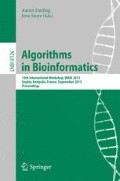Abstract
Comparing strains within the same microbial species has proven effective in the identification of genes and genomic regions responsible for virulence, as well as in the diagnosis and treatment of infectious diseases. In this paper, we present Sibelia, a tool for finding synteny blocks in multiple closely related microbial genomes using iterative de Bruijn graphs. Unlike most other tools, Sibelia can find synteny blocks that are repeated within genomes as well as blocks shared by multiple genomes. It represents synteny blocks in a hierarchy structure with multiple layers, each of which representing a different granularity level. Sibelia has been designed to work efficiently with a large number of microbial genomes; it finds synteny blocks in 31 S. aureus genomes within 31 minutes and in 59 E.coli genomes within 107 minutes on a standard desktop. Sibelia software is distributed under the GNU GPL v2 license and is available at: https://github.com/bioinf/Sibelia. Sibelia’s web-server is available at: http://etool.me/software/sibelia.
Access this chapter
Tax calculation will be finalised at checkout
Purchases are for personal use only
Preview
Unable to display preview. Download preview PDF.
References
Alekseyev, M.A., Pevzner, P.A.: Breakpoint graphs and ancestral genome reconstructions. G.R. 19(5), 943–957 (2009)
Angiuoli, S.V., Salzberg, S.L.: Mugsy: fast multiple alignment of closely related whole genomes. Bioinformatics 27(3), 334–342 (2011)
Blanchette, M., Kent, W., Riemer, C., Elnitski, L., Smit, A., Roskin, K., Baertsch, R., Rosenbloom, K., Clawson, H., Green, E., et al.: Aligning multiple genomic sequences with the threaded blockset aligner. G.R. 14(4), 708–715 (2004)
Brüssow, H., Canchaya, C., Hardt, W.-D.: Phages and the evolution of bacterial pathogens: from genomic rearrangements to lysogenic conversion. Microbiology and Molecular Biology Reviews 68(3), 560–602 (2004)
Chaisson, M., Tesler, G.: Mapping single molecule sequencing reads using basic local alignment with successive refinement (blasr): application and theory. BMC Bioinformatics 13, 238 (2012)
Chambers, H.F., et al.: Community-associated mrsa-resistance and virulence converge. N. Engl. J. Med. 352(14), 1485–1487 (2005)
Chattopadhyay, S., Weissman, S.J., Minin, V.N., Russo, T.A., Dykhuizen, D.E., Sokurenko, E.V.: High frequency of hotspot mutations in core genes of escherichia coli due to short-term positive selection. PNAS 106(30), 12412–12417 (2009)
Darling, A., Mau, B., Blattner, F., Perna, N.: Mauve: multiple alignment of conserved genomic sequence with rearrangements. G.R. 14(7), 1394–1403 (2004)
Gibson, D.G., Benders, G.A., Andrews-Pfannkoch, C., Denisova, E.A., Baden-Tillson, H., Zaveri, J., Stockwell, T.B., Brownley, A., Thomas, D.W., Algire, M.A., et al.: Complete chemical synthesis, assembly, and cloning of a mycoplasma genitalium genome. Science Signalling 319(5867), 1215 (2008)
Kaper, J.B., Nataro, J.P., Mobley, H.L.T.: Pathogenic escherichia coli. Nature Reviews Microbiology 2(2), 123–140 (2004)
Konstantinidis, K., Ramette, A., Tiedje, J.: The bacterial species definition in the genomic era. Philosophical Transactions of the Royal Society B: Biological Sciences 361(1475), 1929–1940 (2006)
Lunter, G., Rocco, A., Mimouni, N., Heger, A., Caldeira, A., Hein, J.: Uncertainty in homology inferences: assessing and improving genomic sequence alignment. G.R. 18(2), 298–309 (2008)
Medvedev, P., Pham, S., Chaisson, M., Tesler, G., Pevzner, P.: Paired de bruijn graphs: a novel approach for incorporating mate pair information into genome assemblers. JCB 18(11), 1625–1634 (2011)
Ohtsubo, E., Sekine, Y.: Bacterial insertion sequences. In: Transposable Elements, pp. 1–26. Springer (1996)
Paten, B., Earl, D., Nguyen, N., Diekhans, M., Zerbino, D., Haussler, D.: Cactus: Algorithms for genome multiple sequence alignment. G.R. 21(9), 1512–1528 (2011)
Peng, Q., Alekseyev, M., Tesler, G., Pevzner, P.: Decoding synteny blocks and large-scale duplications in mammalian and plant genomes. Algorithms in Bioinformatics, 220–232 (2009)
Pevzner, P.A., Tang, H., Tesler, G.: De novo repeat classification and fragment assembly. G.R. 14(9), 1786–1796 (2004)
Pham, S.K., Pevzner, P.A.: Drimm-synteny: decomposing genomes into evolutionary conserved segments. Bioinformatics 26(20), 2509–2516 (2010)
Sinha, A.U., Meller, J.: Cinteny: flexible analysis and visualization of synteny and genome rearrangements in multiple organisms. BMC Bioinformatics 8(1), 82 (2007)
Wayne, L., Brenner, D., et al.: Report of the ad hoc committee on reconciliation of approaches to bacterial systematics. International Journal of Systematic Bacteriology 37(4), 463–464 (1987)
Author information
Authors and Affiliations
Editor information
Editors and Affiliations
Rights and permissions
Copyright information
© 2013 Springer-Verlag Berlin Heidelberg
About this paper
Cite this paper
Minkin, I., Patel, A., Kolmogorov, M., Vyahhi, N., Pham, S. (2013). Sibelia: A Scalable and Comprehensive Synteny Block Generation Tool for Closely Related Microbial Genomes. In: Darling, A., Stoye, J. (eds) Algorithms in Bioinformatics. WABI 2013. Lecture Notes in Computer Science(), vol 8126. Springer, Berlin, Heidelberg. https://doi.org/10.1007/978-3-642-40453-5_17
Download citation
DOI: https://doi.org/10.1007/978-3-642-40453-5_17
Publisher Name: Springer, Berlin, Heidelberg
Print ISBN: 978-3-642-40452-8
Online ISBN: 978-3-642-40453-5
eBook Packages: Computer ScienceComputer Science (R0)

